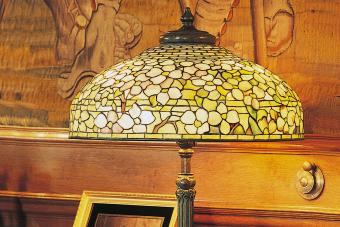
Antique and vintage fabrics have unique designs, colors, and textures that can't be reproduced with modern manufacturing methods. These fabrics are available in limited supplies for all kinds of projects from antique quilt and clothing restoration to historic home decor.
What Is Vintage Fabric?
Most vintage fabrics that you find will be from the 1930s through the 1970s, although it is possible to find yardage from the late 1800s as well. These fabrics may have been found stored in someone's attic or they might have come from bolts of fabric found in some manufacturer's storage room, where they had been long forgotten. The yardage is limited and if you find something you love you should buy it; you may not get a second chance.
Designs and Colors
19th Century
When these old fabrics can be found, they are often somber colors of navy blue, black, and gray. This is partly because the dyes were not colorfast and reds, greens, and yellows fade and change color. Patterns are often stripes or gingham plaids, with floral fabrics seen occasionally, usually in tiny calico patterns.

1920s
The 1920s brought more geometric forms to fabric and color combinations like pink and black. Stylized and Art Deco type prints became popular midway through this decade.

1930s
You may begin to see some reds in the 1930s fabrics. Stylized Art Deco designs were still popular. Paisley is another pattern that you can find a lot of from this decade. In addition to the basic colors you can find pink and teal combinations.

1940s
The 1940s saw fabric patterns move away from the gingham, geometrics, and stripes and patterns of all kinds became popular. Florals in all sizes are easy to find. Purple and lavender were often part of the color combination.

1950s
Floral patterns became larger and bolder. The designs were often scattered on a light colored background with a lot of space between them.

1960s
The 1960s brought mod and psychedelic designs to fabrics. Bold color combinations, optical illusions, and folk are prints became popular.

1970s
Sheer, light fabrics with pindot designs, quiana, and florals were hallmarks of the 1970s.

Where to Buy Vintage and Antique Fabrics
It can be difficult to find vintage fabrics locally because they are not a common item. You may get lucky and find a pattern or two at a garage sale, estate sale, or even at a local thrift shop. Generally, however, you will need to find these specialty fabrics on the Internet. They tend to be expensive, but if you love vintage fabrics, it's worth the cost.
Neisz Vintage Fabrics
Neisz Vintage Fabrics carries a wide assortment of fabric from all eras. They also carry vintage linens, feed sacks, and other vintage items for the home.
Sharon's Antique Vintage Fabrics
Sharon's Antique Vintage Fabrics has everything from feed sacks to vintage upholstery fabrics. All of the fabrics are authentic; there are no reproduction fabrics on site.
Antique Fabrics
Antique Fabrics stocks over 5000 yards of vintage fabric that date from the 1850s to the 1970s. They also offer a restoration service.
Revival Fabrics
Revival Fabrics has authentic vintage fabric from the 1920s to the 1970s.
Vintage and Vogue
Vintage and Vogue is another company that specializes in high quality reproductions of vintage and antique fabrics.
Uses for Antique Fabrics
There are a lot of ways that you can use old fabrics. You probably will not want to use an expensive antique piece to cover the couch in the den, however. These old patterns look great as throw pillows and accent pieces to brighten up your home. Curtains are another good use for the fabrics but use a backing or liner for them to prevent fading. Stuffed bears and dolls that are meant to be used for display look great when made with the old patterns. Lampshades can be covered with 1950s Hawaiian fabrics for a kitschy, casual flair in any room.
If you want a vintage fashion lookm consider making fabric purses, scarves, and other accessories. Vests and other articles of clothing that don't get much strain are good choices as well.
Keep in mind that, depending on how the fabric has been stores, there may be areas of uneven fading and wear.
Care of Old Fabrics
Older fabrics require special care. Use caution when cleaning and working with them; some can be fragile.
- Do not place antique materials in a window or in line with direct sunlight. Old fabrics tend to fade quickly and they can disintegrate if not cared for properly. Avoid using them as curtains unless you have a backing for them.
- All antique fabrics should be hand washed, smoothed out, and carefully hung up to dry. Subjecting them to a washing machine and dryer may render them useless and tattered.
- Never use bleach to whiten vintage linens. Try using a mixture of 1 part lemon juice to 3 parts cool water to whiten yellowed material.
- Do not sew an old fabric to a new one, even if they are the same pattern.
- Store in an acid free paper in a cool dark chest. A cedar chest will keep moths and other bugs out of the fabric and keep it smelling fresh.
Add Vintage Style to Your Life
The bits and pieces of antique fabric can add more style to your life than yards and yards of contemporary materials. When planning your project don't forget to look for old buttons, rick-rack and other embellishments to finish the project with vintage style. Vintage notions, accessories and embellishments combined with antique and vintage fabric can create memorable items for the home.







